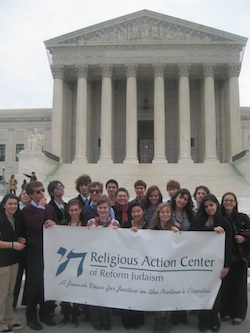By Janis Siegel, JTNews Correspondent
Temple De Hirsch Sinai’s senior rabbi, Daniel Weiner, knows what just about every Jewish professional knows — that to keep Jewish teens interested in even the best extracurricular Jewish studies program, you’ve got to build in some major socializing time.
Temple B’nai Torah’s assistant rabbi, Yohanna Kinberg, picked up on a similar idea for the future of their Hebrew high school after noticing how many teens from TDHS and other Reform congregations in the Seattle area were showing up at its Tuesday night school, just to hang out with their friends there.
It was a natural extension of the obvious for both of them, so in October of this year, they combined the two high schools for a trial run at TDHS’s Bellevue campus. They move to B’nai Torah in February. It makes Jewish education more fun, and all agree that that’s a good thing.
So far, both congregations say the kids really want to come and that parents are happy that their children want to be there. It’s a win-win-win for everyone.
“From a social science point of view, the 9th through 12th grade is a critical time where young people not only affirm their identity as human beings, but particularly as Jews,” Weiner told JTNews. “One of the most compelling aspects of any kind of high school program is the social component.”
“They clearly all know each other and want to be together,” echoed Kinberg. “Some kids are there exclusively for social connections and some kids are there because they want to continue their Judaic studies learning. But part of the challenge of having a high school program like our program is the balance between social and academic.”
Outside of the religious school environment, Reform Jewish teens across the country who belong to the National Federation of Temple Youth meet hundreds of other Jewish teens at events throughout the year. Local teens can also meet their peers in other congregations through the NFTY-affiliated youth groups at Reform synagogues in the area. The individual groups often collaborate on programming, and combine their efforts to connect as many teens as often as possible.
“If we can reaffirm that cohort on a weekly basis as well as during the summer and during monthly youth group events, that’s all to the better,” Weiner said.
About 130 Jewish teens from both congregations attend the weekly one-hour and 45-minute evening sessions, taught by a total of six clergy members and five local instructors from the Jewish community.
Each grade has a core curriculum from which students learn for half the evening, then can choose from a wide range of electives for the remainder.
The 9th grade students’ core class is “Life Cycle and Year Cycle for Big Kids,” an adult perspective on education for post-B’nai Mitzvah kids, based on the Union for Reform Judaism’s Sacred Choices curriculum. Sacred Choices includes life cycles, human sexuality, and dealing with relationships from a Jewish perspective.
Tenth graders study “Judaism and Social Justice” for the first part of year, which culminates in a jam-packed weekend in Washington, D.C. with Jewish youth from across the country, to study the Jewish perspective on critical policy issues. The URJ Religious Action Center’s L’taken weekend program includes a full day of lobbying, where students spend the day on the Hill, talking to representatives about those issues. The rest of the year is spent preparing for Confirmation.
Students in the 11th grade take “Comparative Judaism and Comparative Religions” for their core course, and seniors participate in the URJ’s “Packing for College: Where does Judaism Fit?” curriculum.
“We ask them, ‘What are you looking for in your Jewish life when you leave your parents’ home?’” said Kinberg, “and we give them the skills to find those sources, like a Jewish fraternity or a campus Hillel location.
“The other really important component,” added Kinberg,” is how to talk about Judaism and your background in a larger environment, and also how to talk about Israel, anti-Semitism, stereotypes, and about navigating relationships.”
Electives include “What’s Jewish About ‘Glee’?” as well as leadership and songleading classes, and a course on Israel. The students have opportunities for travel as well.
“The wonderful culminating aspect of our 12th-grade program, which we’ve been doing for about 10 years, is our 12th grade trip to Europe for two weeks to Jewish and non-Jewish sites,” said Weiner. Though in the past it has been a Temple De Hirsch Sinai trip, B’nai Torah kids have always been eligible to join the group. “So far, we’ve taken the students to Italy, Prague, Budapest, and Venice.”
Kinberg believes so much in the value of the combined program she thinks it’s a mistake to pass it up.
“I really believe that kids who do not go to our program leave this area and the Reform congregations at a disadvantage because there are so many positive and mind-expanding experiences through this program,” she said. “We really want to make the Jewish lives of our students bigger.”
